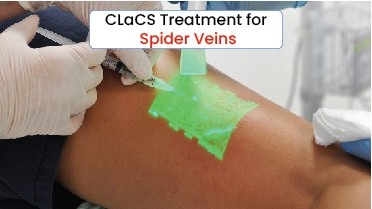Spider veins, those small red, blue, or purple veins that appear on the legs and face, can be a cosmetic concern and sometimes cause discomfort. While traditional treatments like sclerotherapy and laser therapy have been used to address this issue, a newer technique known as CLaCS (Cryo-Laser and Cryo-Sclerotherapy) is gaining traction for its effectiveness and minimal invasiveness. Let’s explore what CLaCS is and why it’s becoming a popular choice for treating spider veins.
What is CLaCS?
CLaCS is an innovative treatment method that combines laser therapy, sclerotherapy, and cryotherapy into one comprehensive procedure. Here’s how it works:
- Laser Therapy: A transdermal laser is used to target and heat the spider veins through the skin. This process causes the blood within the veins to coagulate, leading to the collapse of the vessel walls. Over time, these treated veins are reabsorbed by the body, effectively reducing their visibility.
- Cryotherapy: To enhance patient comfort and protect the skin, a cooling device blows a continuous stream of cold air onto the treatment area. This cryotherapy element helps to numb the skin and reduce the discomfort typically associated with laser treatments.
- Sclerotherapy: After the laser treatment, a sclerosant—a specialized chemical solution—is injected directly into the spider veins. This solution irritates the vein lining, causing the vein to close off and eventually be absorbed by the body.
Advantages of CLaCS
CLaCS offers several benefits that make it a preferred treatment for spider veins:
- Minimally Invasive: Unlike more invasive vein treatments, CLaCS requires no incisions or stitches. The procedure is performed with just a laser and fine needles, which significantly reduces the risk of complications and speeds up the recovery process.
- Enhanced Comfort: The inclusion of cryotherapy in the treatment process helps minimize pain and discomfort. This is a major advantage over traditional methods, which can often be painful and require longer recovery times.
- High Effectiveness: By combining laser and sclerotherapy, CLaCS targets spider veins from both the outside and inside, ensuring a comprehensive approach to vein treatment. This dual-action increases the likelihood of fully eliminating the veins and reduces the chance of them reappearing.
- Quick Recovery: Most patients experience minimal downtime after CLaCS treatment. While some may have mild redness or swelling immediately following the procedure, these effects typically subside within a few days. Patients can usually resume their normal activities right away, making it a convenient option.
Ideal Candidates for CLaCS
CLaCS is suitable for a wide range of individuals with spider veins, particularly those who want a less invasive treatment or have not had success with other methods. It is especially effective for treating spider veins on the legs, but it can also be used on the face and other areas.
However, not everyone is a candidate for CLaCS. Those with certain medical conditions, such as severe venous insufficiency or active skin infections, may not be suitable for the procedure. A consultation with a qualified vein specialist is essential to determine if CLaCS is the right option for you.
What to Expect During and After the Procedure
A CLaCS procedure typically takes about 30 to 60 minutes, depending on the extent of the treatment area. The process is relatively straightforward: the skin is cleansed, and a numbing cream may be applied to ensure comfort. During the treatment, you may feel a mild tingling sensation from the laser and a cooling effect from the cryotherapy, but significant pain is rare.
After the procedure, you might notice some mild redness, swelling, or bruising, but these are usually temporary and resolve quickly. Wearing compression stockings for a short period post-treatment can help support the veins and promote healing.
CLaCS is a cutting-edge treatment that offers a minimally invasive, effective solution for spider veins with minimal discomfort and downtime. By combining laser therapy, cryotherapy, and sclerotherapy, CLaCS provides a thorough approach to vein care. If spider veins are a concern for you, consider consulting with a vein specialist to see if CLaCS is the right treatment for you.



